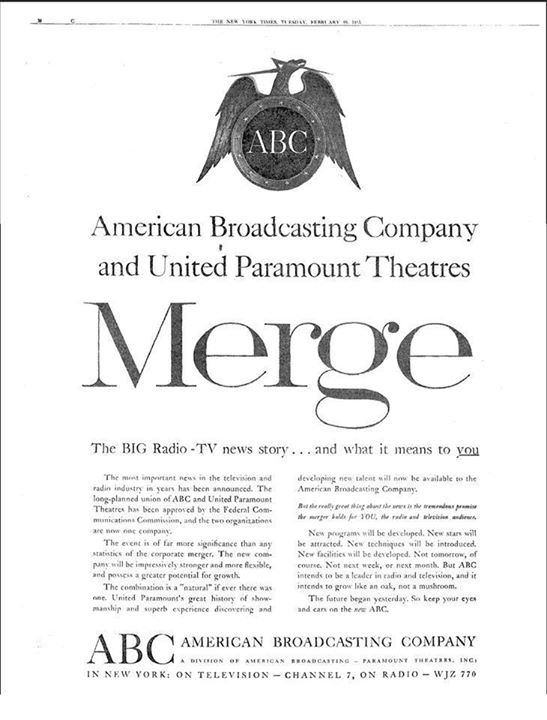

February 9, 1953…ABC Is Born Again With A Mega Merger
February 9, 1953…ABC Is Born Again With A Mega Merger
That was the day United Paramount, led by Leonard Goldenson, came to the rescue and saved the company from bankruptcy.
On October 12, 1943, Edward John Noble, the owner of Life Savers candy, and the radio station WMCA in New York, bought NBC’s Blue Network for $8 million.
This was the start of ABC, but even with Noble’s millions, the first 10 years was a hard slog financially. The one thing ABC did that would later made the struggling network so appealing to a new buyer was something done on a whim, that cost them nothing.
Without asking Nobles, ABC’s chief engineer had applied to the FCC for Construction Permits for 5 television licenses, all on Channel 7, in New York, Chicago, San Francisco, Los Angeles and Detroit. Shortly after, the FCC froze license applications due to an overwhelming crush of requests. The next part, putting these stations on the air would cost big money, and that is where the financial squeeze got serious. That was 1948.
In much the same way NBC was forced to sell the Blue Network,
the movie theater operator United Paramount Theaters (UPT) was forced to become an independent entity, separating itself from the film studio Paramount Pictures in 1949.
For its part, ABC was on the verge of bankruptcy, and in 1951, Noble borrowed $5 million from the Prudential Insurance Company to save the company…at least for the time being.
Leonard Goldenson, the president of UPT, approached Noble in 1951 and proposed that UPT purchase ABC. Noble received further offers, including one from Bill Paley of CBS. Goldenson and Noble reached a tentative agreement in the late spring of 1951 that ABC would become a subsidiary of UPT, but would remain autonomous in its management.
On June 6, 1951, UPT’s board of directors validated their tentative agreement. However, the transaction had to be approved by the FCC. Insofar as the Paramount Pictures film studio was already a shareholder of the DuMont Television Network, the FCC conducted a series of hearings to ensure whether Paramount was truly separated from United Paramount Theaters, and whether it was violating antitrust laws.
In 1952, when the FCC ended its freeze on applications for new stations, among the issues to be addressed was the approval of the merger between UPT and ABC.
On February 9, 1953, the FCC authorized UPT’s purchase of ABC in exchange for $25 million in shares, and the company was renamed American Broadcasting-Paramount Theaters, Inc.
The new company was based in Paramount’s headquarters at 1501 Broadway in New York, and owned six AM radio stations, several FMs, as well as five TV stations and 644 cinemas in 300 cities throughout the United States.
In consideration of this merger, UPT sold its television station in Chicago, WBKB-TV, to CBS for $6 million. CBS changed the calls to WBBM-TV. They kept ABC’s existing Chicago station, WENR-TV but moved the WBKB call letters to channel 7, which would eventually become WLS-TV. Goldenson began to sell some of the old theaters to finance the new television network.
On May 1, 1953, ABC’s flagship stations – WJZ, WJZ-FM and WJZ-TV in New York – adopted the callsigns of WABC, WABC-FM and WABC-TV, and moved to 7 West 66th Street, one block from Central Park.
At the same time, Goldenson had been trying to convince his movie studio friends to provide content for the network. ABC’s merger with UPT led to the creation of relationships with Hollywood’s film production studios, breaking a long quarantine that had existed between film and television.
Goldenson’s efforts paid off, and on October 27, 1954, the network was able to launch a “New ABC” campaign with the productions of several studios, including Metro-Goldwyn-Mayer, Warner Bros., and 20th Century Fox. This was the start of the TV westerns.
Before that though, the most iconic (and ironic) of ABC’s relationships with Hollywood producers was its agreement with Walt Disney. Walt and his brother Roy contacted Goldenson at the end of 1953 to ask ABC to finance part of the Disneyland project in exchange for Disney’s production of a television series.
Walt wanted ABC to invest $500,000 and a guarantee of $4.5 million in additional loans, a third of the budget intended for the park. Around 1954, ABC agreed to finance Disneyland in exchange for the broadcasting of a new television program, “Disneyland”, which debuted on the ABC network on October 27, 1954, as the first of many anthology TV programs that Disney would broadcast over the course of the next fifty years. We all know the rest of the story! Enjoy and share! -Bobby Ellerbee
Great story! For those of us who were around, this helps put everything into perspective.
I had never heard how ABC got the Ch 7 franchise.
“The FCC conducted a series of hearings to ensure whether Paramount was truly separated from United Paramount Theaters, and whether it was violating antitrust laws.” – Those FCC hearings were held in the Old Post Office Building in downtown DC, which is now the Trump Hotel on Pennsylvania Avenue.
Disney never ran on Sundays during its ABC years. ‘Disneyland’ was originally seen Wednesdays 7:30-8:30.
I guess this would also explain ABC-Paramount Records… I guess… 🙂